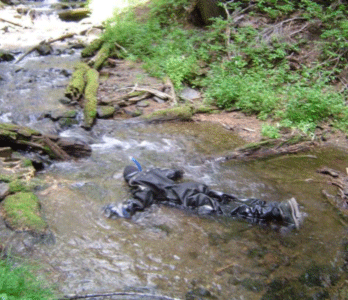
Lee Webb Historic Conditions When Crater Lake National Park was established in 1902, native Bull Trout (Salvelinus confluentus) occupied many streams and rivers of southern Oregon's Upper Klamath Basin. Within Crater Lake National Park, Bull Trout occurred naturally in Sun Creek and lower Annie Creek. Fish Stocking Introduced Brook Trout Very early in the twentieth century, people began to stock nonnative trout in southern Oregon streams to improve sport fishing. The introduction of nonnative trout, particularly Brook Trout (S. fontinalis), caused a dramatic decline in the distribution and abundance of Bull Trout. Brook Trout compete for resources with Bull Trout and also hybridize with the native species to produce sterile offspring. Early Bull Trout Conservation During the late 1980s, surveys by National Park Service scientists determined that Bull Trout no longer occurred in Annie Creek and were limited to a small area near the headwaters of Sun Creek. Brook Trout were found throughout both streams. This finding was typical of the Upper Klamath Basin where at least 40% of historical Bull Trout populations have disappeared. Bull Trout were listed as a threatened species under the federal Endangered Species Act in 1999. 
NPS
In 1992, Crater Lake National Park began a long-term project to conserve and recover the remaining Bull Trout in Sun Creek. Because competition and hybridization with nonnative trout were the principal threats to the native species, conservation efforts focused on removing nonnative fish. Biologists installed small dams, or "fish barriers," in Sun Creek to prevent new Brook Trout from entering the stream and then used a combination of methods, including electrofishing, snorkeling, and the fish toxin antimycin-A, to remove the nonnatives while preserving Bull Trout. Program Results The approach proved successful. Bull Trout distribution in Sun Creek has expanded, and Bull Trout abundance in the stream, once as low as 200 fish, has increased roughly ten-fold. Conservation and Recovery outside of Crater Lake National Park Recently, the Bull Trout recovery program at Crater Lake has entered a new phase of work, collaborating with the State of Oregon to expand Sun Creek Bull Trout distribution downstream from the national park onto the adjacent Sun Pass State Forest. Biologists are using the same strategy that was successful farther upstream: first installing fish barriers to prevent Brook Trout invasion, then removing nonnative fish and monitoring subsequent Bull Trout recovery. Long-term Conservation and Recovery Goal Ultimately, biologists hope that Bull Trout will recolonize all of Sun Creek and begin to disperse to other historical habitats nearby. To achieve this goal, Crater Lake National Park is working with partner agencies to improve the connection between Sun Creek and the Upper Klamath Basin. For More Information Buktenica, M.W., D.K. Hering, S.F. Girdner, B.D. Mahoney, and B.D. Rosenlund. 2013. Eradication of Non-native Brook Trout using Electrofishing and Antimycin-A and the Response of a Remnant Bull Trout Population. North American Journal of Fisheries Management. 33:117–129.
|
Last updated: February 28, 2015
